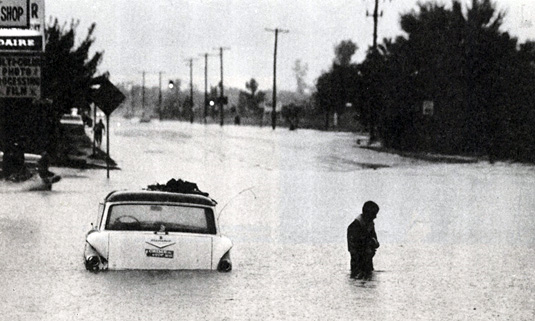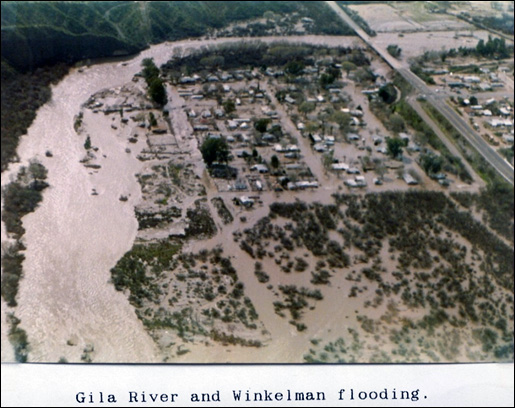
On this page you learn what types of flooding are typical in Arizona and how do you protect yourself, your family and your home. You will also find out more about the signficant Arizona floods. Finally, you'll find links to NWS offices that provide forecast and safety information for Arizona, as well as links to our partners who play a significant role in keeping you safe.
Learn More: A prolonged moist southwest upper air flow produced significant rainfall on the steep slopes of the Mogollon Rim. Flooding occurred over much of the state as a result of the rainfall. Amounts ranged from 1-4 inches in the south-central part of the state, 3-6 inches in the central basins, and five to eleven inches over and just below the Rim and White Mountains. These rains were just the latest in a long series of significant rains that began in late December 1977. The previous rains saturated watersheds, raised stream levels, and nearly filled most reservoirs. The most extensive flooding occurred in the Salt and Verde Basins. Although there was some snow melt above 6,500 feet, most of the runoff resulted from the rain. Runoff into the Salt River above Roosevelt Dam was contained by Roosevelt Lake but the smaller dams could not contain runoff that came down the Verde River and the Salt River below Roosevelt Dam. As a result, a huge volume of water rushed down the normally dry Salt River bed and became a raging torrent through the Phoenix area and western Maricopa County. Volume at the peak was 138,000 cfs on March 2.
In the Phoenix area, approaches to eight street bridges were washed away, leaving only three intact to handle the daily movement of tens of thousands of vehicles. Traffic was backed up for miles during the rush hours for about a week until the flow of water was contained in the reservoirs and approaches were filled back in on some of the crossings. The water broke about 2,000 feet of the east end of the main runway at Phoenix Sky Harbor Airport into large chunks and damaged airport radio and radar facilities. Thousands of homes were damaged and more than 100 homes were destroyed. Flooding also occurred along the Little Colorado River, with considerable damage occurring in the Winslow area. Most of the runoff came from tributaries with headwaters on the Mogollon Rim. There were minor overflows of the Gila River with some damage in the Safford Valley and at Duncan. On the Hopi and Navajo Indian Reservations, most of the roads were made impassable, stranding about 10,000 individuals. Food had to be air lifted in, as well as fodder for livestock. This event resulted in four fatalities and damages estimated at $65.9 million.
Learn More:
Learn More:
 |
Photos:
Learn More:
The highest flows of record were observed at some stream flow gaging stations in every major river basin in the state. The protracted rainfall over the 2-week period caused multiple flood peaks on most streams and rivers and resulted in the inundation of a large number of communities throughout the state. A large garbage landfill and portions of the new Mill Avenue bridge, under construction in Tempe, were washed away by the raging Salt River. The Gillespie Dam west of Phoenix was damaged, as high water spread throughout low-lying areas. Roads, bridges, homes and businesses suffered considerable damage in Pima County. Several thousand people were isolated in their homes, as flood waters from the Rillito River cut off all roads. Two major bridges over the Santa Cruz River were closed as well as many roads in Greenlee and Graham Counties due to flooding. Duncan was one of the hardest hit, with half of the town flooded when a dike broke, leaving at least 150 people homeless. Uncontrolled flow passed over the Coolidge Dam spillways for the first time since it was built: 8 deaths and 112 injuries were attributed to the floods. Estimated damages to public and private property exceeded $400 million (U.S. Army Corps of Engineers, 1994). This flood event resulted in Arizona creating a Flood Warning Multi-Agency Task Force to improve interagency coordination and for the establishment of a flood warning system for the state.
Photos:
Learn More:
|
||||||